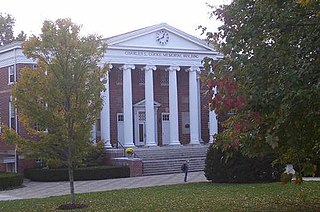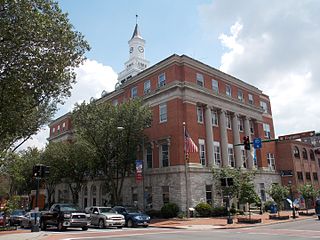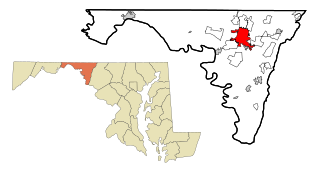
Washington County is a county located in the western part of the U.S. state of Maryland. As of the 2020 census, the population was 154,705. It is the most populous county in the Western Maryland region and its county seat is Hagerstown.

Concordia Theological Seminary is a Lutheran seminary in Fort Wayne, Indiana. It offers professional, master's degrees, and doctoral degrees affiliated with training clergy and deaconesses for the Lutheran Church–Missouri Synod (LCMS).

Bethany Lutheran College (BLC) is a private Christian liberal arts college in Mankato, Minnesota. Founded in 1927, BLC is operated by the Evangelical Lutheran Synod. The campus overlooks the Minnesota River valley in a community of 53,000.

The Lutheran Theological Seminary at Gettysburg was a seminary of the Evangelical Lutheran Church in America (ELCA) in Gettysburg, Pennsylvania. It was one of seven ELCA seminaries, one of the three seminaries in the Eastern Cluster of Lutheran Seminaries, and a member institution of the Washington Theological Consortium. It was founded in 1826 under prominent but controversial theologian and professor Samuel Simon Schmucker (1799-1873) for the recently organized General Synod of the Evangelical Lutheran Church in the United States. The seminary was the oldest continuing Lutheran seminary in the United States until it was merged on July 1, 2017, after 189 years of operation, with the nearby and former rival Lutheran Theological Seminary at Philadelphia to form the United Lutheran Seminary. The new institution continues to use both campuses.

Bela Lyon Pratt was an American sculptor from Connecticut.
Martin Luther University College, formerly Waterloo Lutheran Seminary, is a seminary of the Evangelical Lutheran Church in Canada federated with Wilfrid Laurier University, located in Waterloo, Ontario.

Samuel Simon Schmucker was a German-American Lutheran pastor and theologian. He was integral to the founding of the Lutheran church body known as the General Synod, as well as the oldest continuously operating Lutheran seminary and college in North America.
Dean Stanley Lesher was an American newspaper publisher, founder of the Contra Costa Times and the Contra Costa Newspapers chain. He was also a well-known philanthropist in the San Francisco Bay Area.
The following is a timeline of women's colleges in the United States. These are institutions of higher education in the United States whose student population comprises exclusively, or almost exclusively, women. They are often liberal arts colleges. There are approximately 35 active women's colleges in the U.S. as of 2021.

Michigan Lutheran Seminary (MLS) is a coeducational, private preparatory school for boarding and day students in grades 9 through 12. Located in Saginaw, Michigan, the school encourages students to become pastors and teachers in the Wisconsin Evangelical Lutheran Synod, continuing their education at Martin Luther College in New Ulm, Minnesota.

Women's colleges in the Southern United States refers to undergraduate, bachelor's degree–granting institutions, often liberal arts colleges, whose student populations consist exclusively or almost exclusively of women, located in the Southern United States. Many started first as girls' seminaries or academies. Salem College is the oldest female educational institution in the South and Wesleyan College is the first that was established specifically as a college for women, closely followed by Judson College in 1838. Some schools, such as Salem College, offer coeducational courses at the graduate level.
Robert McKee is a former member of the Maryland House of Delegates, having represented District 2A, which covers part of Washington County. McKee was first elected into office in 1994 when he defeated Democrat Richard E. Roulette. In 1998 he ran unopposed. In 2002, he defeated Peter E. Perini Sr. with 75% of the vote and in 2006, he again ran unopposed, out-matching the write-ins with 99.2% of the vote.

The Hagerstown–Martinsburg metropolitan area, officially designated by the United States Office of Management and Budget (OMB) as Hagerstown–Martinsburg, Maryland–West Virginia Metropolitan Statistical Area (MSA), constitutes the primary cities of Hagerstown, Maryland; Martinsburg, West Virginia; and surrounding areas in three counties: Washington County, Maryland; Berkeley County, West Virginia; and Morgan County, West Virginia. The metro area lies mainly within the rich, fertile Cumberland and Shenandoah valleys, and is approximately a 60–90 minute drive from Washington, D.C.; Baltimore, Maryland; and Harrisburg, Pennsylvania; Hagerstown is approximately 75 miles (121 km) driving distance from all three cities. The population of the metropolitan area as of 2008 is 263,753.

Hagerstown is a city in and the county seat of Washington County, Maryland, United States. The population was 43,527 at the 2020 census. Hagerstown ranks as Maryland's sixth-most populous incorporated city and is the most populous city in the Maryland Panhandle.

Benjamin Kurtz was a German-American Lutheran pastor and theologian. He was part of the revivalist movement of the Lutheran Church in the 19th century, ran the Lutheran faith-based newspaper Lutheran Observer, founded the Lutheran faith-based Missionary Institute in Selinsgrove, Pennsylvania, and assisted in the founding of the Gettysburg Seminary.
Christian Hansen, commonly known as C. X. Hansen, was an American educator and historian in the Lutheran church. He was integral to the formation of the Danish Evangelical Lutheran Church in North America and the United Danish Evangelical Lutheran Church.

Concordia College was an educational institution of the Lutheran Church–Missouri Synod (LCMS) whose main purpose was to prepare men to enter one of the synod's seminaries. It was founded as a German-style gymnasium in Perry County, Missouri, in 1839. It was moved to St. Louis, Missouri, in 1847, and ultimately to Fort Wayne, Indiana, in 1861. In 1935, the high school department of the school was separated from the junior college to form Concordia Lutheran High School. Concordia College was closed in 1957 when the LCMS opened Concordia Senior College on a new campus in Fort Wayne..The former campus was purchased by the Indiana Institute of Technology.

Cornelius Luther Keedy was an American pastor, physician, and academic administrator. He served as owner and president of Kee Mar College for 25 years.
Annie S. Kemerer (1865-1951), was an art collector who founded the Kemerer Museum of Decorative Arts in Bethlehem, Pennsylvania upon her death in 1951.
















